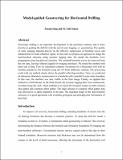Model-guided Geosteering for Horizontal Drilling
Author(s)
Song, Fuxian; Toksoz, M. Nafi
DownloadSong_2009-2.pdf (5.056Mb)
Other Contributors
Massachusetts Institute of Technology. Earth Resources Laboratory
Metadata
Show full item recordAbstract
Horizontal drilling is an important development in the petroleum industry and it relies
heavily on guiding the drill bit with the aid of sonic logging, i.e. geosteering. The quality
of sonic imaging depends heavily on the effective suppression of borehole waves and
enhancement of weak reflection signal. To this end, we propose an approach to image the
near-borehole structure using acoustic logging data. We model the borehole wave
propagation using log-derived velocities. The modeled borehole waves are removed from
the raw data, leaving reflected signals for imaging interfaces. We tested this method with
three sets of data. First we calculated synthetic waveforms for a horizontal well with an
interface parallel to the borehole using the 3D finite difference method. The processing
result with our method clearly shows the parallel reflecting interface. Next, we conducted
an ultrasonic laboratory measurement in a borehole with a parallel Lucite-water boundary.
In this case, the interface was also visible in the final image. Finally, we applied this
method to a field dataset. In the field dataset, the acoustic logging data were continuously
recorded along the well, which enabled us to reject the borehole modes in both common
shot gather and common offset gather. The large amount of common offset gather data
also allowed us to apply migration to the data. The migrated image of the near-borehole
structure is in good agreement with available geological and petrophysical information of
that field.
Date issued
2009Publisher
Massachusetts Institute of Technology. Earth Resources Laboratory
Series/Report no.
Earth Resources Laboratory Industry Consortia Annual Report;2009-05
Keywords
Logging, Migration